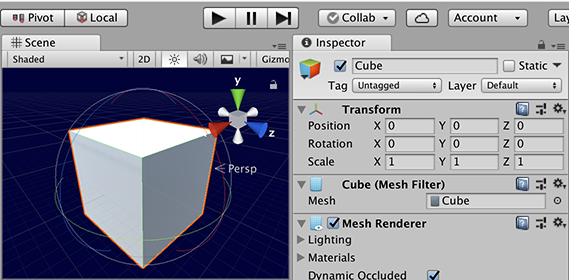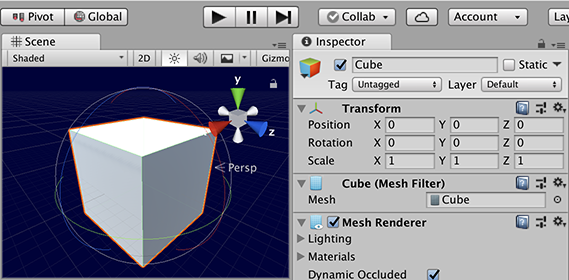How To Make A Object Rotate With The Camera Unity
Description
Use Transform.Rotate to rotate GameObjects in a variety of ways. The rotation is often provided equally an Euler angle and not a Quaternion.
You tin specify a rotation in earth axes or local axes.
World axis rotation uses the coordinate organisation of the Scene, so when you lot start rotate a GameObject, its x, y, and z axes are aligned with the x, y, and z world axes. So if you rotate a cube in world infinite, its axes align with the world. When you select a cube in the Unity Editor's Scene view, rotation Gizmos announced for the left/right, up/down and frontwards/back rotation axes. Moving these Gizmos rotates the cube around the axes. If you lot de-select and then re-select the cube, the axes restart in world alignment.
Local rotation uses the coordinate system of the GameObject itself. And so, a newly created cube uses its x, y, and z axis set up to zero rotation. Rotating the cube updates the rotation axes. If you de-select and the re-select the cube, the axes are shown in the same orientation as earlier.

A cube not rotated in Local Gizmo Toggle

A cube rotated in Local Gizmo Toggle

A cube not rotated in Global Gizmo Toggle

A cube rotated in Global Gizmo Toggle
For more information on Rotation in Unity, see Rotation and Orientation in Unity.
Annunciation
public void Rotate(Vector3 eulers, Space relativeTo = Space.Cocky);
Parameters
| eulers | The rotation to apply in euler angles. |
| relativeTo | Determines whether to rotate the GameObject either locally to the GameObject or relative to the Scene in world infinite. |
Description
Applies a rotation of eulerAngles.z degrees around the z-axis, eulerAngles.x degrees around the x-axis, and eulerAngles.y degrees around the y-axis (in that guild).
Rotate takes a Vector3 argument every bit an Euler angle. The second statement is the rotation axes, which tin be set to local axis (Space.Self) or global axis (Space.World). The rotation is past the Euler corporeality.
Announcement
public void Rotate(float xAngle, float yAngle, float zAngle, Space relativeTo = Space.Cocky);
Parameters
| relativeTo | Determines whether to rotate the GameObject either locally to the GameObject or relative to the Scene in earth space. |
| xAngle | Degrees to rotate the GameObject effectually the X axis. |
| yAngle | Degrees to rotate the GameObject effectually the Y axis. |
| zAngle | Degrees to rotate the GameObject around the Z axis. |
Clarification
The implementation of this method applies a rotation of zAngle degrees around the z axis, xAngle degrees effectually the x axis, and yAngle degrees around the y axis (in that order).
Rotate can accept the euler angle specified in iii floats for x, y, and z.
The instance shows two cubes: one cube uses Space.Self (the local space and axes of the GameObject) and the other uses Space.World (the space and axes in relation to the /Scene/). They are both showtime rotated xc in the X axis and so they are non aligned with the world centrality by default. Use the xAngle, yAngle and zAngle values exposed in the inspector to see how different rotation values apply to both cubes. You might notice the way the cubes visually rotate is dependant on the current orientation and Space option used. Play around with the values while selecting the cubes in the scene view to attempt to understand how the values interact.
using UnityEngine;// Transform.Rotate example // // This script creates two different cubes: one red which is rotated using Space.Self; one green which is rotated using Space.Globe. // Add information technology onto any GameObject in a scene and striking play to come across it run. The rotation is controlled using xAngle, yAngle and zAngle, modifiable on the inspector.
public class ExampleScript : MonoBehaviour { public float xAngle, yAngle, zAngle;
individual GameObject cube1, cube2;
void Awake() { cube1 = GameObject.CreatePrimitive(PrimitiveType.Cube); cube1.transform.position = new Vector3(0.75f, 0.0f, 0.0f); cube1.transform.Rotate(90.0f, 0.0f, 0.0f, Infinite.Self); cube1.GetComponent<Renderer>().material.color = Color.red; cube1.name = "Cocky";
cube2 = GameObject.CreatePrimitive(PrimitiveType.Cube); cube2.transform.position = new Vector3(-0.75f, 0.0f, 0.0f); cube2.transform.Rotate(xc.0f, 0.0f, 0.0f, Space.Earth); cube2.GetComponent<Renderer>().material.color = Color.green; cube2.proper noun = "World"; }
void Update() { cube1.transform.Rotate(xAngle, yAngle, zAngle, Space.Self); cube2.transform.Rotate(xAngle, yAngle, zAngle, Space.World); } }
Declaration
public void Rotate(Vector3 axis, float angle, Space relativeTo = Space.Self);
Parameters
| angle | The degrees of rotation to use. |
| axis | The axis to employ rotation to. |
| relativeTo | Determines whether to rotate the GameObject either locally to the GameObject or relative to the Scene in world space. |
Description
Rotates the object around the given axis past the number of degrees divers by the given angle.
Rotate has an axis, angle and the local or global parameters. The rotation axis tin can exist in any direction.
Annunciation
public void Rotate(Vector3 eulers);
Parameters
| eulers | The rotation to apply in euler angles. |
Clarification
Applies a rotation of eulerAngles.z degrees around the z-axis, eulerAngles.10 degrees around the x-centrality, and eulerAngles.y degrees around the y-axis (in that society).
The rotation is relative to the GameObject's local space (Space.Self).
Declaration
public void Rotate(float xAngle, float yAngle, bladder zAngle);
Parameters
| xAngle | Degrees to rotate the GameObject around the X centrality. |
| yAngle | Degrees to rotate the GameObject effectually the Y axis. |
| zAngle | Degrees to rotate the GameObject effectually the Z centrality. |
Description
The implementation of this method applies a rotation of zAngle degrees effectually the z axis, xAngle degrees effectually the 10 centrality, and yAngle degrees around the y centrality (in that order).
The rotation is relative to the GameObject's local space (Infinite.Self).
Declaration
public void Rotate(Vector3 axis, bladder angle);
Parameters
| axis | The axis to apply rotation to. |
| angle | The degrees of rotation to use. |
Clarification
Rotates the object around the given axis by the number of degrees defined by the given angle.
Rotate has an centrality, angle and the local or global parameters. The rotation centrality tin be in any direction. The rotation is relative to the GameObject's local infinite (Space.Cocky).
Source: https://docs.unity3d.com/ScriptReference/Transform.Rotate.html
Posted by: petersacal1959.blogspot.com

0 Response to "How To Make A Object Rotate With The Camera Unity"
Post a Comment